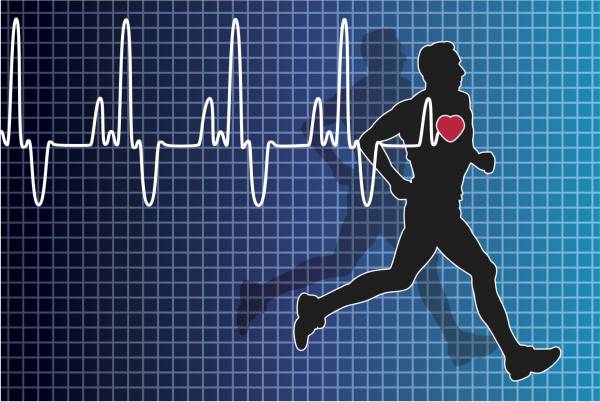It’s not any big revelation that the heart is the most vital organ in our body. This is true in both a literal sense and a figurative sense. It’s also true that the best way to develop the strength of your heart (also both literally and figuratively) is to use it. We cannot protect our heart from being uncomfortable and, in fact, doing so is what causes our heart to weaken. Vigorous exercise is not necessarily fun, and neither is making ourselves vulnerable to having a broken heart, but putting your heart ‘out there’ and making it work hard is the way we develop a strong and healthy one.
We have a lot of data to support the claim of using our hearts to their fullest and many of us now know the results of our exercise in real time. Indeed one of the many trends to hit the fitness industry in recent years is that of instant information. We have machines, bracelets, and Fitbits that can tell us everything from our heart rates, to calories burned, to steps taken. There are tons of apps that track calories and help us design our workouts. As a coach, I sometimes wonder if coaching will go the way of dinosaurs with so much data readily available at our fingertips.
While exercise and diet fads will come and go, the focus on data and information is here to stay. Knowledge is power and ultimately knowledge and wisdom are what will save our ailing society. Data is key and no data is more important than the information as it relates to the all mighty heart rate. The heart rate tells us how hard we’re working when we’re exercising (max HR), how hard our heart has to work while we’re at rest (resting HR), and how quickly our heart recovers from exercise (exercise recovery HR). These are all important indicators of fitness and the health of our heart. They also are correlated and interconnected. What the data shows us is that when we use our hearts properly and vigorously, we recover faster and are healthier for it.
In the past year, much of my focus professionally has been on heart rate interval training. The idea has been to help people train in peak training zones to optimize their fitness levels. As noted in a recent article of mine, training anaerobically is also a great way for the body to consume calories and make one a better athlete. When you train anaerobically (at 84% and above of your estimated max HR), the body’s calorie consumption mode kicks into overdrive and we burn more calories at rest too. This is part of the reason anaerobic athletes have the shredded physiques most of us covet. They’re willing to get those heart rates up into those uncomfortable zones.
 Certainly fat burning and becoming more athletic are things that people want, but something else comes along with such training – better health. Exercise recovery heart rate is one of the biggest predictors of cardiovascular health. As anyone who has had a heart condition can attest to, one of the first things a physician will do in evaluating the health of a heart is a stress (or treadmill) test. The stress test is pretty simple. Put someone on a treadmill and have them exercise up to a strenuous point and then see how quickly they recover. Heart rate recovery is a measurement of how quickly one recovers in the first two minutes after peak exercise. The first minute of recovery is the most important indicator.
Certainly fat burning and becoming more athletic are things that people want, but something else comes along with such training – better health. Exercise recovery heart rate is one of the biggest predictors of cardiovascular health. As anyone who has had a heart condition can attest to, one of the first things a physician will do in evaluating the health of a heart is a stress (or treadmill) test. The stress test is pretty simple. Put someone on a treadmill and have them exercise up to a strenuous point and then see how quickly they recover. Heart rate recovery is a measurement of how quickly one recovers in the first two minutes after peak exercise. The first minute of recovery is the most important indicator.
In a study by the Cleveland Clinic Exercise Laboratory in Ohio, Michael S. Lauer, MD, the lead researcher of the study, found that people with abnormal heart rate recovery, which consists of a decrease of twelve or less beats per minute, were at a greater risk for death from heart disease than those with normal heart rate recovery, which is a decrease of fifteen to 25 beats per minute.
Athletes recover quickly and their heart is better for it. Like any functioning part of the body the heart is best served by being exercised. Athletes don’t struggle to recover and so they don’t struggle mentally to buy into exercising intensely the way a novice exerciser does. It often takes a sedentary person’s heart a long period to recover, meaning they are uncomfortable much longer than the athlete. As for getting into athlete shape, it certainly takes work to get there, but the science shows us it’s more than worth it – lower mortality rates, better physiques, and feeling better while exercising intensely. The key is buying in psychologically to getting uncomfortable, as it is with many things in life.
It all seems pretty straightforward and simple, right? Start doing interval training and getting the heart rate to recover faster by working harder. But again, harder work is not always easy. For many, just starting a regular exercise program can seem daunting, let alone the prospect of having to get really, really uncomfortable doing things like uphill sprints. Many would just rather do the elliptical machine. The truth is, though, the elliptical machine probably won’t get us there unless we’re sprinting on it.
 I have witnessed time and time again this past year what happens as people become better and better conditioned as they do heart rate interval training. They become athletes and get in tiptop shape from anaerobic training. Their physiques change to look more like an athlete and their bodies become calorie-burning machines. Through such training, I have seen huge improvements in things like running times and, of course, exercise recovery heart rate times. All good, right? Definitely, but there is one additional hurdle to overcome and again it’s a psychological one.
I have witnessed time and time again this past year what happens as people become better and better conditioned as they do heart rate interval training. They become athletes and get in tiptop shape from anaerobic training. Their physiques change to look more like an athlete and their bodies become calorie-burning machines. Through such training, I have seen huge improvements in things like running times and, of course, exercise recovery heart rate times. All good, right? Definitely, but there is one additional hurdle to overcome and again it’s a psychological one.
As noted, data reigns supreme these days and when we see results we like, such as high heart rates and calories burned, we come to expect these results. Many come to expect achieving the high exercise heart rates and the calories burned. So, the thing is, as we become better athletes, we will spend more time in the recovery heart rate training zone, which might make us feel like we aren’t achieving the same results as when we have a more consistent, higher heart rate. However, what really is happening is that we are becoming better athletes and our hearts are recovering more quickly. As you experience more stress along the way, it won’t be easy, but you’ll recover with increasing speed, and your heart and health will thank you for it.
Photos courtesy of Shutterstock.






